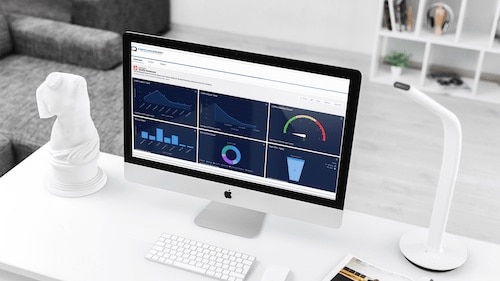As some parts of the globe are beginning to move forward into the next phase of recovery, businesses look to technology for help reopening the workplace as quickly as possible, while keeping employees, customers, and communities safe. “With employees, customers, and suppliers, their wellness and readiness are more intertwined than ever before,” shares ComplianceQuest CEO, Prashanth Rajendran. “And we see that an enterprise’s ability to return to work safely requires the employees, customers, visitors, and its supply chain to all be at the ready to support the return to work safely.”
ComplianceQuest is one of the AppExchange partners extending Work.com, using its passion and expertise in quality, safety, and compliance management to help businesses reopen. The AppExchange team spent time chatting with the Tampa-based Rajendran to learn more about how wellness, readiness, and technology are all critical checkpoints on the path to the next phase and beyond. Check out the highlights from our conversation.

Prashanth Rajendran, CEO, ComplianceQuest
Being in the supply chain space, I’m sure you’ve seen a radical impact to your customers over the last several months. What challenges have they faced and how are they beginning the journey to return to work?
Rajendran:
We’ve seen how COVID-19 has deeply disrupted the supply chain of most companies around the world. Supply chain leaders are grappling with new supplier qualification, upgrading quality processes for old and new suppliers, and modifying supply chains almost entirely.
When you look at a supply chain, it’s comprised of enterprises and individuals, whether that’s contractors or small suppliers. Many times, it’s not just providing products, but also providing services. But behind all that, it’s people. As companies start to look at returning to work, they must consider the people — this means employee wellness, the wellness of your customers, and the wellness of your supply chain.
Wellness and readiness are deeply connected, probably more so than ever.
What can organizations do to determine their supply chain readiness with this newfound wellness lens?
Rajendran:
Pre-COVID, pre-pandemic, people were already using supply quality management solutions to manage the health and quality of the suppliers on an ongoing basis. Now, through Work.com, we’re creating a solution for organizations to really zero in on specific components that are needed pre and post supply quality, which is the definite identification of your critical suppliers. Today, that’s being done largely through emails and phone calls, and the data is not consistent nor does it roll-up. Information may be available, but without data rolling up, an organization cannot have a clear dashboard to understand to what extent your supply chain is ready.
How can Work.com and ComplianceQuest help businesses in their return to work journey?
Rajendran:
There was a clear ask from the marketplace saying that part of returning to work safely requires suppliers to be an integral part. How do businesses determine the supply chain is ready with what they need to provide? Whether it’s capacity, operational compliance, or regulatory compliance, are they doing what they need to be doing to keep their employees safe and your supply chain unhindered?
Within Work.com, we’re automating this supply chain readiness workflow end-to-end through a series of features and capabilities. We’re also providing a visualization layer to be able to expose readiness precisely by location — whether city, state, or country. What extent are we seeing readiness? Are we fully ready, are we partially ready, are we not ready at all? This data is paramount for any business, and especially for organizations with global supply chains. It helps companies concentrate efforts to bring locations to the necessary level of readiness.
“Wellness and readiness are deeply connected, probably more so than ever.” –Prashanth Rajendran
Let’s zoom out and look at the bigger picture outside of supply chains. What are ways that businesses can use technology to pivot or reimagine processes, given most of the playbook from pre-pandemic doesn’t necessarily apply?
Rajendran:
I think it comes down to empowerment. Companies need to empower their employees to innovate using technology, especially now since you can’t be customer-focused without technology.
Simply saying, ‘I’m using emails and phone calls’ is not enough. With remote and distance working, how do you make it seamless, regardless of the location? Instead, you need to be saying, ‘How do I transform my current process to allow my staff to be wherever they are?’
Secondly, you cannot innovate in a vacuum. Focus on empowering the people closest to the customer, because they know what needs to be done to maintain that customer excellence. Innovation starts at the frontline.
Also, utilize technology to drive and empower employees to take a purpose-driven approach. Transformation isn’t simply taking what you have currently and putting it into a piece of software. It’s putting customer success front and center, which could make your business ask itself, ‘How do I move from a system of record into a system of engagement?’
“You can’t be customer-focused without technology.” –Prashanth Rajendran
And lastly, companies should also look at cross-training employees. More than likely, you’re going to have teams working partial shifts. Rather than being at 100% capacity, whether due to natural attrition, capacity reduction, or social distancing, you’re only going to have maybe 40–50% capacity. This means you have to cross-train employees to be able to do what’s necessary. Only then can you quickly pivot as needed.
Thank you, Prashanth and ComplianceQuest for helping companies, and, in turn, communities, on the road to reopening and returning to work safely. Learn more about ComplianceQuest and other solutions that extend Work.com at AppExchange COVID-19 Resources.
This post was originally published on the AppExchange and the Salesforce Ecosystem blog.




























